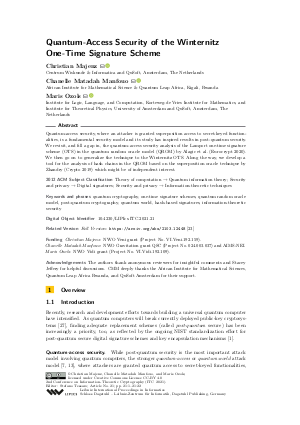@InProceedings{majenz_et_al:LIPIcs.ITC.2021.21,
author = {Majenz, Christian and Manfouo, Chanelle Matadah and Ozols, Maris},
title = {{Quantum-Access Security of the Winternitz One-Time Signature Scheme}},
booktitle = {2nd Conference on Information-Theoretic Cryptography (ITC 2021)},
pages = {21:1--21:22},
series = {Leibniz International Proceedings in Informatics (LIPIcs)},
ISBN = {978-3-95977-197-9},
ISSN = {1868-8969},
year = {2021},
volume = {199},
editor = {Tessaro, Stefano},
publisher = {Schloss Dagstuhl -- Leibniz-Zentrum f{\"u}r Informatik},
address = {Dagstuhl, Germany},
URL = {https://drops-dev.dagstuhl.de/entities/document/10.4230/LIPIcs.ITC.2021.21},
URN = {urn:nbn:de:0030-drops-143406},
doi = {10.4230/LIPIcs.ITC.2021.21},
annote = {Keywords: quantum cryptography, one-time signature schemes, quantum random oracle model, post-quantum cryptography, quantum world, hash-based signatures, information-theoretic security}
}

 Creative Commons Attribution 4.0 International license
Creative Commons Attribution 4.0 International license
